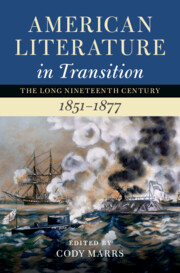Book contents
- American Literature in Transition, 1851–1877
- Nineteenth-Century American Literature in Transition
- American Literature in Transition, 1851–1877
- Copyright page
- Contents
- Figures
- Contributors
- Series Preface
- Introduction
- Part I Careers
- Part II Networks
- Chapter 8 Newspapers and Periodicals
- Chapter 9 Transamerican Literature
- Chapter 10 Oceanic Literature
- Chapter 11 Romanticism
- Chapter 12 Realism
- Part III Exchanges
- Part IV The Long Civil War
- Index
Chapter 8 - Newspapers and Periodicals
from Part II - Networks
Published online by Cambridge University Press: 15 June 2022
- American Literature in Transition, 1851–1877
- Nineteenth-Century American Literature in Transition
- American Literature in Transition, 1851–1877
- Copyright page
- Contents
- Figures
- Contributors
- Series Preface
- Introduction
- Part I Careers
- Part II Networks
- Chapter 8 Newspapers and Periodicals
- Chapter 9 Transamerican Literature
- Chapter 10 Oceanic Literature
- Chapter 11 Romanticism
- Chapter 12 Realism
- Part III Exchanges
- Part IV The Long Civil War
- Index
Summary
In a review of Graham’s Magazine published in the March 1, 1845 issue of The Broadway Journal, Edgar Allan Poe predicted of magazine literature, “[i]n a few years its importance will be found to have increased in geometrical ratio” because “[t]he whole tendency of the age is Magazine-ward.” Busy mid-century readers, speeding along in “the rush of the age,” required a medium that kept pace. “We now demand the light artillery of the intellect,” Poe insisted: “we need the curt, the condensed, the pointed, the readily diffused – in place of the verbose, the detailed, the voluminous, the inaccessible.”1 It can be difficult to pin down how seriously Poe took such declarations. Praise and ironic critique intertwine in his critical writings, as in subsequent paragraphs of this review, where he describes the engraving “Dacota Woman and the Assiniboin Girl” as “worthy of all commendation,” while another engraving in the same issue, “The Love Letter,” “has the air of having been carved by a very small child, with a dull knife, from a raw potato.”2 If Poe marks a genuine trend toward periodical forms of literature in the period, he also stages an ambiguous response to the trend, vacillating between praise and condemnation.
Keywords
- Type
- Chapter
- Information
- American Literature in Transition, 1851–1877 , pp. 127 - 144Publisher: Cambridge University PressPrint publication year: 2022

